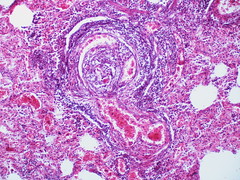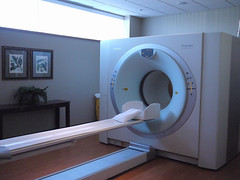Myers' AP Psychology for AP*: Unit 3B Flashcards
Terms : Hide Images [1]
| 4921886854 | Lesion | tissue destruction. It can occur naturally or experimentally by the caused distruction/remove of brain tissues |  | 0 |
| 4921886855 | Electroencephalogram (EEG) | An amplified recording of the waves of electrical activity that sweep across the brain's surface. These waves are measured by electrodes placed on the scalp. | 1 | |
| 4921886856 | CT (computed tomography) scan | a series of x-ray photographs taken from different angles and combined by computer into a composite representaion of a slice through the body. Aslo called a CAT scan |  | 2 |
| 4921886857 | (PET) Positron emission tomography scan | A visual display of brain activity that detects where a radioactive form of glucose goes while the brain performs a given task. | 3 | |
| 4921886858 | MRI (magnetic resonance imaging) | a TECHNIQUE THAT USES MAGNETIC FIELDS AND RADIO WAVES TO PRODUCE COMPUTER generated images that distinguish among different types of soft tissues; allows us to see structures within the brain. |  | 4 |
| 4921886859 | Brainstem | the oldest part and central core of brain. AKA reticular formation, or reticular activating system. In charge of automatic survival functions |  | 5 |
| 4921886860 | Medualla | The base of the brainstem. responsible for breathing and circulation. (heart beat) |  | 6 |
| 4921886861 | Reticular Formation | Responisble for arousal |  | 7 |
| 4921886862 | Pons | sleep and arousal |  | 8 |
| 4921886863 | Forebrain | rostral to the midbrain, in the anterior and middle cranial fossa - The anterior portion of the brain; the part of the brain that develops from the anterior part of the neural tube. |  | 9 |
| 4921886864 | Midbrain | located between the pons and the forebrain - relay or switching station; sends message onto the correct parts of the brain |  | 10 |
| 4921886865 | Hindbrain | most primitive part of the brain - information is processed outside of our awareness without any conscious effort |  | 11 |
| 4921886866 | Thalamus | the brains 'sensory switch board' Located at top of brainstem; directs messages to the sensory areas and transmits them to cerebellum and medulla. |  | 12 |
| 4921886867 | Cerebellum | "little brain" In charge of muscle movement, balance, and coordination. |  | 13 |
| 4921886868 | Limbic system | A system of neural structures at the border of brainstem. Associated with emotions like fear, agression, and drives such as those for food and sex. Includes the Hippocampus, Amygdala and hypothalamus. |  | 14 |
| 4921886869 | Amygdala | 2 neural clusters that are components of the limbic system and are linked to emotion. SEED OF EMOTION |  | 15 |
| 4921886870 | hypothalamous | a neural structure lying below the thalamus. directs 'eathing, drinking, body temperature' linked to emotion. |  | 16 |
| 4921886871 | Hippocampus | Limpc system. Learning and memory matcher. |  | 17 |
| 4921886872 | Cerebral cortex | Fabric of interconnected neuron cells. Higher order thinking. Takes meaning and puts it to focus. |  | 18 |
| 4921886873 | Glial Cells | Cells in the nervous system that support, nourish, and protect neurons. | 19 | |
| 4921886874 | Frontal Lobes | the portion of the cerebral cortex lying just behind the forehead; involved in speaking and muscle movements and in making plans and judgements. |  | 20 |
| 4921886875 | Parietal lobes | The portion of the cerebral cortex lying at the top of the head and toward the rear; includes the sensory cortex. |  | 21 |
| 4921886876 | Occipital lobes | the portion of the cerebral cortex lying at the back of the head; includes the visual areas, which receive visual info from the opposite visual feild. |  | 22 |
| 4921886877 | temporal lobes | The portion of the cerebral cortex lying roughyl above the ears; includes the auditory areas, each of which revieves aditory info primarily from the opposite end. |  | 23 |
| 4921886878 | motor cortex | an area at the rear of the frontal lobes that controls voluntary movements. |  | 24 |
| 4921886879 | Association areas | Areas of the cerebral cortex that are not invoved in primary motor or sensory funtions; they are involved in higher mental funtions such as learning, remebering, thinking and speaking. |  | 25 |
| 4921886880 | Sesory cortex | the area at the front of the parietal lobes that registers and processes body sensations. |  | 26 |
| 4921886881 | Aphasia | impairment of language, usually caused by Left Hemisphere damage to Brocas area or Wernickes. |  | 27 |
| 4921886882 | Broca's area | controls language expression. Damage creates inability to muscles in left hemisphere connected to speech. YOU cnt talk |  | 28 |
| 4921886883 | Wernickes area | Contorls language reception. Damage creates inability to comprehend language; usually in the left temporal lobe |  | 29 |
| 4921886884 | Plasticity | the brain's capacity for modification, as evident in brain modifications, as evident in brain reorganization following damage (especially in children) and in experiments on the effects of experience on brain development. |  | 30 |
| 4921886885 | Neurogenesis | starts after conception with embryonic stem cells differentiating into immature neurons |  | 31 |
| 4921886886 | Corpus Callosum | Shares info back and forth; Connects the two hemispheres of the brain and carries messages between them. |  | 32 |
| 4921886887 | Split Brain | A condition in which the two hemispheres of the brain are isolated by cutting the connecting fibers (corpus callosum) between them. |  | 33 |
| 4921886888 | Consciousness | our awareness of ourselves and our environment. |  | 34 |
| 4921886889 | Cognitive Neuroscience | the study of how people perceive, remember, think, speak, and solve problems |  | 35 |
| 4921886890 | Dual Processing | a phenomenon can occur in two different ways, or as a result of two different processes |  | 36 |
| 4921886891 | Paul Broca | discovered area in the brain (named for him) in the left frontal lobe responsible for language production |  | 37 |
| 4921886892 | Phineas Gage | railroad worker who survived a severe brain injury that dramatically changed his personality and behavior; case played a role in the development of the understanding of the localization of brain function |  | 38 |
| 4921886893 | Michael Gazzaniga | 1939-present; Field: cognition (neuroscience); Studied of the neural basis of mind with primary responsibility for initiating human split-brain research. In his subsequent work he has made important advances in our understanding of functional lateralization in the brain and how the cerebral hemispheres communicate with one another. |  | 39 |
| 4921886894 | Roger Sperry | scientist who won a Nobel Prize for work with SPLIT BRAIN patients |  | 40 |
| 4921886895 | Karl Wernicke | "Wernicke's area"; discovered area of left temporal lobe that involved language understanding: person damaged in this area uses correct words but they do not make sense |  | 41 |
